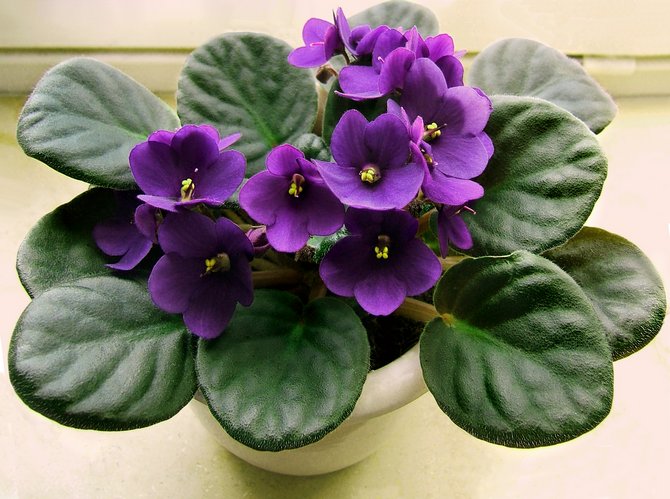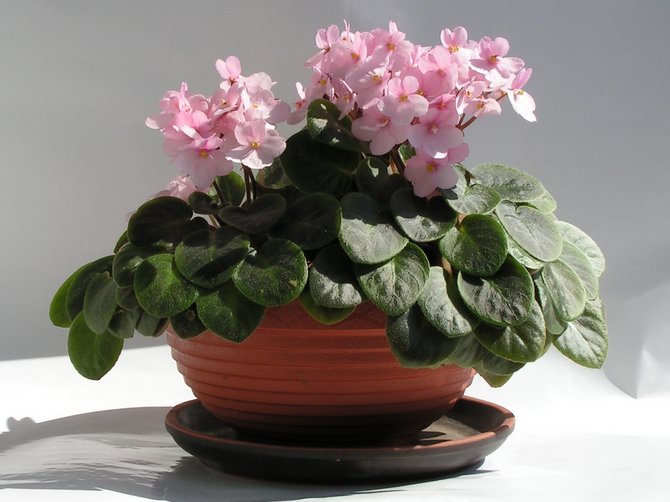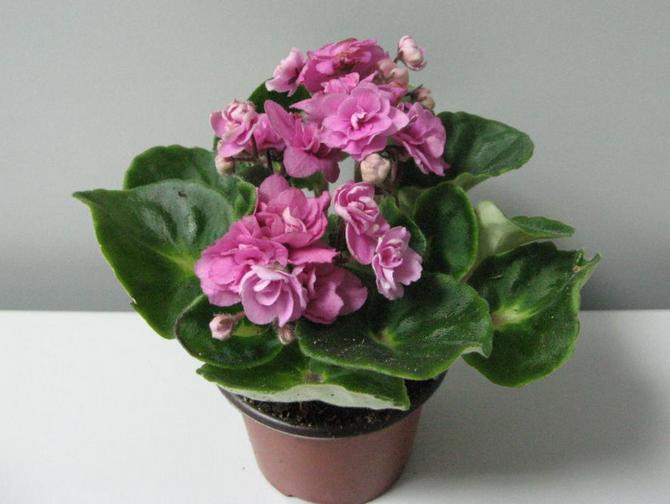Saintpaulia is the flower that can be found everywhere: on the window at the grandmother’s, on the table in the office, at the seasoned florist and at the novice amateur. A small fluffy rosette, easily recognizable at first sight, with beautiful flowers on small legs, very unpretentious and widespread. All this is Saintpaulia or home violet. Known to everyone from childhood, with soft double leaves and small purple-blue flowers blooming at any time of the year, unpretentious, always finding a place on the windowsill among other flowers.
In fact, there are an incredible variety of varieties of Violet Usambara, unique plants in price reach the amount of several tens of dollars. Clubs and associations of lovers and breeders of this plant have been created around the world, the differences in varieties range from the size of the rosette to the shape of the flower petals..
Violet classification
By outlet diameter
- Microminiatures: up to 6 cm, plant “on the palm”
- Miniature: up to 15 cm
- Semi-miniature: up to 20 cm, there is no strict separation with standard ones
- Standard: up to 40 cm
- Large standard (large): over 40 cm no limit
By type of leaves
- Shape: round, elongated, curved, bustle and pointed
- Leaf edge: wavy, smooth, serrated, fringed
- Color: solid green, two-tone, bordering variegated, mosaic variegated and chimeras
- Placement: on an elongated petiole, on a shortened, flattened crown or lush
- By the size, structure and color of the inflorescences of Saintpaulia, this is the most detailed part of the plant classification.
- By flower shape: “bell”, “star”, “wasp” and classic
- By the number of petals: simple (5 petals), comb (7), semi-double (in 2 rows), terry (several rows)
- By the shape of the petals: pointed, rounded, fringed, lace, smooth, even, wavy
- By color of flowers: here the imagination of breeders knows no bounds. Colors from black-violet to white, monochromatic, bi-color and multi-color. Now you can find a variety with green-yellow petals, very rare
Fantasy varieties are arranged according to the basic tone with drops, strokes, stripes and splashes of a different color, which, in combination of different colors, gives the flowers an extraordinary and exotic look.
Bordered varieties flaunt with flowers, as if they were dipped in paint of an excellent tone, two-border specimens are especially appreciated. However, it is not necessary for a novice florist to immediately acquire expensive varietal layering, first it is necessary to “practice” in growing more simple and unpretentious in everyday life Usambar violets.
Home violet (saintpaulia) care
Lighting. Direct rays of the sun will burn the delicate leaves in a matter of days, the light should be diffused, it can be shaded, but the length of daylight hours should be as long as possible. In winter, during flowering, Saintpaulia will require additional lighting, otherwise the color will not pass in full force, it will end faster and much weaker. However, you can give the plant a special rest in cold weather by shading it..
Temperature. Not more than +25 degrees Celsius, lower temperatures, up to +6, home violet tolerates quite easily.
Watering and moisturizing. Water for irrigation should always be warm, while dripping on the leaves should be avoided. It is recommended to pour the liquid into the pan – the safest solution against acidification and flooding of the soil. Air humidification is required when radiator batteries are close, leaves can be wiped with a damp cloth or soft brush to remove accumulated dust.
Planting and transplanting. The plant is planted in sod land mixed with coarse sand and wood ash. At the same time, the pot should not be very large – the root system of Saintpaulia is poorly developed, it is located close to the surface, without deepening. The bare trunk of the plant must be covered, this is very important.
It is advisable to transplant the plant only if it is necessary to change the pot or the contaminated soil, the least traumatic way is to fill it with water for 10 minutes and roll the bush onto your hand with the crown down, passing it between your fingers. We remove the old vessel – and the entire root system with a lump of earth in front of the eyes, damage is excluded, you can carefully examine the transplant object. Remove dead and withering leaves, separate the daughter rosettes, check the roots for rot and insects, and plant the sprout back in a prepared pot. Dredge is poured up to the lower leaf stalks, raising the leaves above the level of the dishes and watered. After a couple of days, pour a layer on the sagging places..
Reproduction. The most affordable techniques are leaves and daughter outlets, ready for self-planting. The sockets are shaded for the first time and covered with a transparent bag. Usually, very soon, a young plant is mastered in a separate pot and continues its independent life. They begin to bloom after six months with the right care.
Leaves for rooting are cut off only from the bottom, leaving an elongated petiole, it is he who will be immersed in water or a mixture of wet peat and sand, it is from it that the roots begin to break through and the future bush is formed. When decaying, the affected part is cut off at an angle and planted again. The glass turned upside down on a sheet has proven itself excellently, performing the function of a micro greenhouse and a guard against mechanical damage.
Pests and diseases. Gray rot is especially dangerous: it affects the rosette, roots and lower leaves with constant flooding and acidification of the soil, it is very similar to mold. Torn dry spots on the leaves occur after sunburn, dry soil and excess fertilizer.
Insects often include whiteflies, cyclamen mites and mealybugs. If you notice their appearance in time and treat them with insecticides, then problems should not arise..
A few quick tips for growing and caring for Saintpaulia
1.start with inexpensive and unpretentious copies
2.Place flowers away from direct sunlight, but not in the shade
3.Artificially lengthen the daylight hours for blooming Violets
4.Pour gently with warm water or from a pan
5.Periodically humidify dry air
6.Remove dried flowers and leaves in time
7.Isolate affected plants immediately until the problem is resolved



